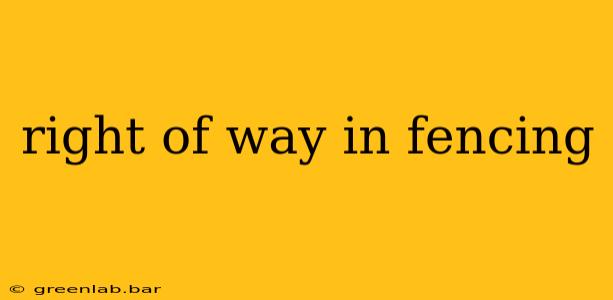Navigating the complexities of property lines and fencing can be challenging, especially when dealing with rights of way. Understanding your rights and responsibilities regarding fencing near a right of way is crucial to avoid disputes and ensure compliance with the law. This comprehensive guide clarifies the often-murky waters of right of way and fencing regulations.
What is a Right of Way?
A right of way is a legal right to cross or use someone else's land for a specific purpose. This can range from a public right of way, like a footpath or road, to a private right of way, granted through an easement or other legal agreement. These rights can be established through various means, including:
- Prescription: Continuous and uninterrupted use of a path for a specified period (typically 20 years in many jurisdictions).
- Implied Grant: A right of way implied from the circumstances of the sale or lease of land.
- Express Grant: A written agreement explicitly granting a right of way.
The exact definition and legal implications of a right of way vary significantly depending on location and specific circumstances. It's essential to consult local laws and potentially seek legal counsel for definitive clarification.
Fencing Near a Right of Way: Key Considerations
Fencing near a right of way presents unique challenges. The location of the fence in relation to the boundary of the right of way is paramount. Incorrectly placed fencing can lead to legal disputes and potential removal. Key considerations include:
1. Boundary Determination:
Precisely establishing the boundary of the right of way is the first and often most crucial step. This usually requires examining land registry documents, title deeds, and potentially conducting a land survey. Understanding the exact limits of the right of way will determine where your fence can legally be erected.
2. Access and Maintenance:
Fencing near a right of way must not impede the lawful use of that right of way. This means ensuring sufficient space is maintained for safe and convenient passage. Overhanging branches, obstructing fences, or gates that unduly restrict access can all lead to legal issues. Furthermore, responsibility for maintaining the fence may be shared or fall solely on the landowner depending on the specific agreement and local regulations.
3. Height and Materials:
The height and materials used in fencing near a right of way might be subject to specific regulations. Some jurisdictions limit the height of fences to preserve visibility or prevent encroachment. Similarly, the materials used might be restricted to ensure safety and maintain the aesthetic character of the area.
4. Public vs. Private Rights of Way:
The rules governing fencing near a public right of way differ significantly from those concerning private rights of way. Public rights of way often have additional regulations and oversight from local authorities. Fencing near a public right of way might require planning permission or consent from the relevant council or governing body.
Avoiding Disputes and Ensuring Compliance
To avoid costly and time-consuming legal battles, proactive steps are vital:
- Consult with Professionals: Engage a surveyor to establish the precise boundary of the right of way and ensure proper fence placement. Seek legal advice to understand your rights and responsibilities.
- Review Local Regulations: Familiarize yourself with all relevant local bylaws, planning regulations, and any specific rules governing fencing near rights of way in your area.
- Document Everything: Keep thorough records of all surveys, agreements, communications, and any permissions obtained.
- Communicate Clearly: Maintain open communication with any adjoining landowners or relevant authorities to avoid misunderstandings and potential disputes.
Conclusion
Fencing near a right of way requires careful consideration of legal boundaries, access requirements, and relevant regulations. By understanding your rights and responsibilities, engaging with professionals when necessary, and prioritizing open communication, you can prevent disputes and ensure your fencing project complies with the law. Remember, the details of right of way and fencing regulations can vary significantly depending on location. Always seek professional advice tailored to your specific situation.

